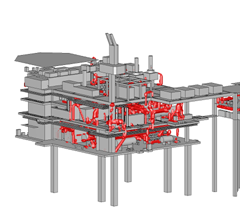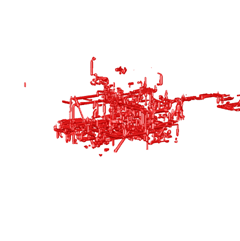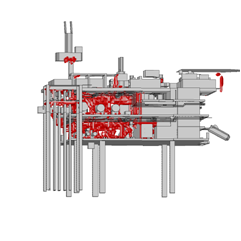ACE Method
The ACE method was developed to provide a consistent approach for describing
the resistance to flow due to small-scale subgrid geometry features such as pipework,
which is abundant within many of the energy sector applications considered by Abercus.
Prior to the development of the ACE method, the predominant technique for modelling small-scale
congestion was to describe the congestion by a representative pipe diameter and pipe spacing.
Since both of these parameters are dependent upon the interpretation of the analyst, which is a human factor,
this method is inherently inconsistent - given one complex array of congestion, different users will
inevitably select different representative pipe parameters.
The ACE method avoids any inconsistancies by automatically allocating resistances to the flow within the CFD model.
The congestion is compiled within a congestion database using, for example, the
GeomAuditry tool. Each record within the congestion
database represents one pipe and comprises seven numbers - the x, y and z-coordinates of the start location of the pipe,
the x, y and z-coordinates of the end location of the pipe, and the pipe diameter. Upon import of each pipe from the
congestion database,the ACE implementation allocates resistances to the flow along the length of the pipe, according to the
pipe diameter and the length of pipe within each cell, as shown in the images
below.

|

|

|

|
|
Congestion, with platform shown
|
Congestion, without platform shown
|
The ACE method is implemented using the UDF functionality of the FLUENT CFD code (by Ansys) and is designed for use on
general unstructured meshes. The implementation of the ACE method was completed by Alice Ely
in 2004 during the course of her MSc at the
University of Leeds. Her thesis is available for download here: Thesis - ACE method.
Abercus is currently working on a new ACE implementation that will extend the same
functionality to a range of CFD codes, including CFX, OpenFOAM and StarCCM.